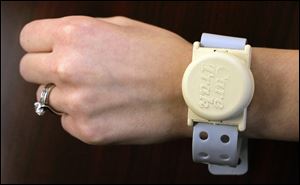
‘Lifesaver’ program to begin in Wood Co.
Wristband helps locate those prone to wander
1/14/2013
The electronic tracking service will help track Alzheimer's patients and others. The wristwatch-style FM transmitters send signals that can be picked up by receivers three or more miles away.
It’s a scene Ottawa County Sheriff Steve Levorchick can’t forget.
An elderly woman had wandered away from her home in the middle of a winter’s night. When she was found the next day, she had frozen to death.
“I don’t want to ever do that again,” the sheriff said. “That’s why I’m such an advocate of Project Lifesaver.”
A voluntary program, Project Lifesaver provides wristbands embedded with tiny radio transmitters to elderly residents with dementia, children with autism, war veterans with brain injuries, and others prone to wandering off.
If a person goes missing, sheriff’s deputies can activate a receiver that can track them within a few miles of where he or she was last seen.
While Ottawa County has offered Project Lifesaver to residents since 2005 and both Defiance and Allen counties have gotten on board, Sheriff Levorchick is on a quest to spread it to more northwest Ohio counties. As he sees it, the more counties that have the equipment and training, the larger the safety net.
The Wood County Sheriff’s Office plans to launch the program this spring, Chief Deputy Eric Reynolds said.
“We get call-outs where a loved one has wandered away, and time is of the essence,” he said, explaining that missing persons not only may come to physical harm, but are potential crime victims.
Chief Deputy Reynolds estimated the sheriff’s office handles four to six calls a year of an elderly person who has wandered away from home.
“It’s another safeguard,” he said of Project Lifesaver. “Nothing’s 100 percent, but I think as a caregiver, it would give me some peace of mind.”
The sheriff’s office is working with organizations including the Wood County Committee on Aging, Wood Lane, and the Wood County Veterans Assistance Center to implement Project Lifesaver. The Committee on Aging, he said, has agreed to contribute the start-up cost of $4,500, which will pay for two hand-held receivers, two receivers that can be temporarily mounted on a cruiser, two wristbands, and training for three deputies.
The North Baltimore Eagles Club is donating four additional wristbands, and the sheriff’s office is continuing to look for donations to buy more. Each costs about $380, and the county hopes to provide them for free to residents.
Chief Deputy Reynolds said there is a $10 monthly cost to change the battery and wristband that users or their caregivers would be asked to pay, though he did not think anyone would be turned away if he or she were unable to pay.
Denise Niese, executive director of the Wood County Committee on Aging, said she’s been aware of the program for years and is happy to see it’s finally going to be available locally.
“I think Project Lifesaver will be a tremendous asset for the residents who are in need of this additional safety net,” Ms. Niese said.
In Ottawa County, just one client in the program has gone missing. Sheriff Levorchick said the transmitter and receiver worked exactly as intended during the August incident in Port Clinton.
“Within 37 minutes, we had him located approximately a half-mile from his home, sitting in the front yard of a house,” the sheriff said. “He was cold and his legs were tired.”
Ottawa County has 10 extra transmitters, and Sheriff Levorchick would like to enroll people to use them.
“One person who goes missing who’s a wanderer is a person we’re not protecting, and we don’t want that,” he said.
Contact Jennifer Feehan at: jfeehan@theblade.com or 419-724-6129.